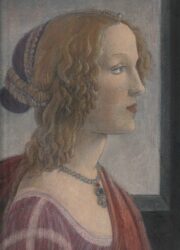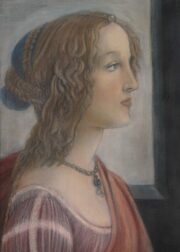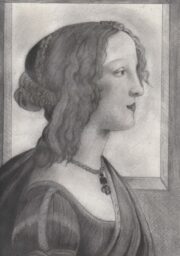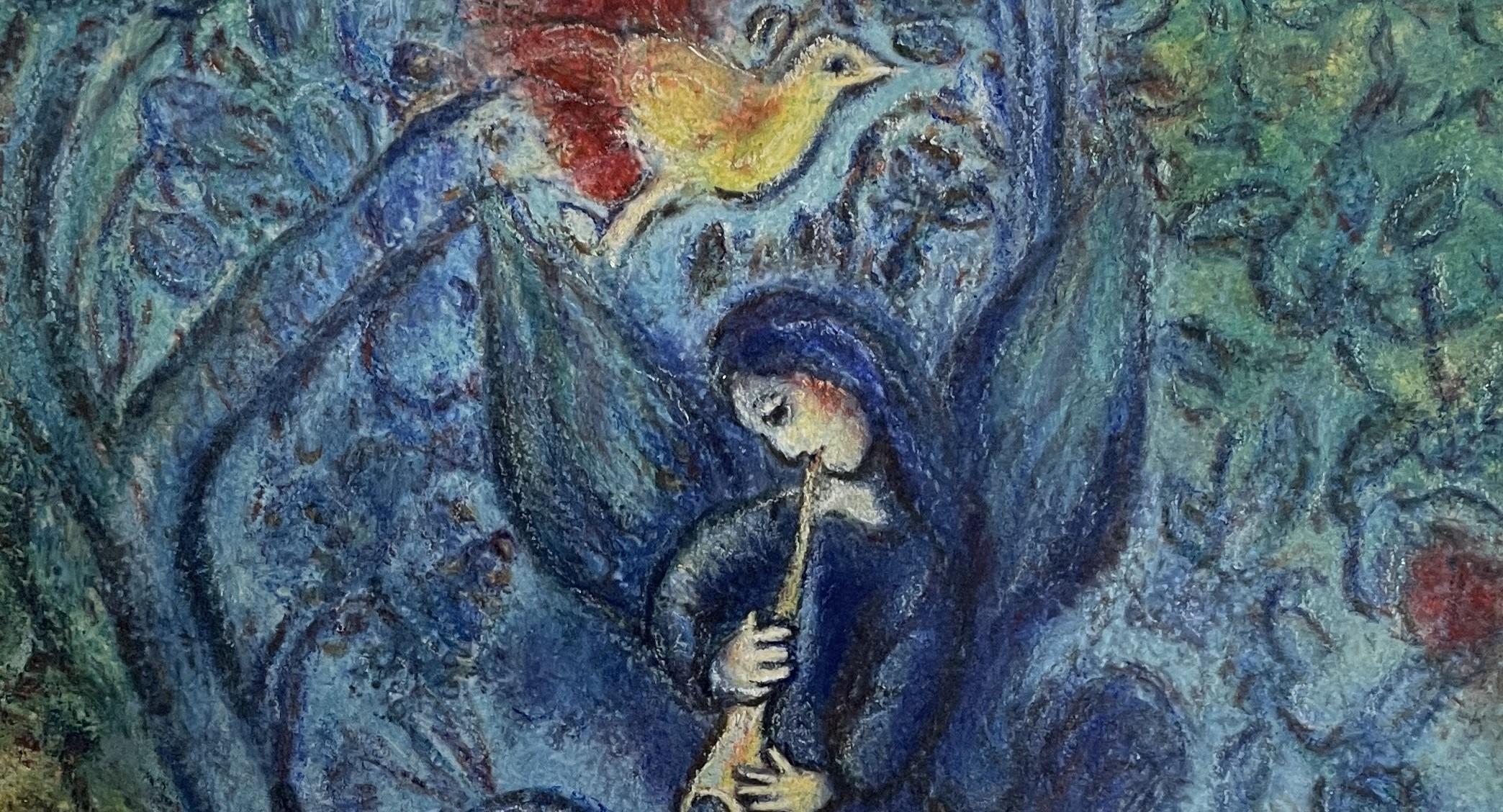日本語-Englishー台灣華語
サンドロ・ボッティチェリ「麗しきシモネッタの肖像」

La Bella Simonetta
美麗的西蒙內塔肖像

La Bella Simonetta
美麗的西蒙內塔肖像

La Bella Simonetta
美麗的西蒙內塔肖像
ウフィッツィー美術館はいつも混んでいる。はじめて訪れた時も一時間待ちと言われたが、小さかった息子が「うんち」と騒いだおかげで、どさくさに紛れて直ぐに入館することができた。ボッティチェリの部屋はとりわけ列をなして混んでいたが、出口に立っていた警備員が顔をしかめながら、下の方の手をしきりに横に振っている。わからないように出口から入れという合図らしい。こうして私はボッティチェリの「ヴィーナスの誕生」をはじめて観た。
それは画集でみるのとは大きな違いのある、とても美しい絵だった。優美な曲線で描かれた女性が、一糸まとわぬ姿で豊かなブロンドの髪をなびかせるその絵の、何と美しく清らかなことか。ギリシャ神話に名を借りて人間の肉体を賛美した画面からは、宗教という呪縛から解放されたルネサンスという時代の歓びが、今も伝わってくる。その時代の理想の全てが、その肉体の中に込められているかのようだ。
この絵は丸紅が所蔵するシモネッタ・ヴェスプッチの肖像画である。この三十年の間に三回しか公開されていないが、私は一度だけ実際に見たことがある。シモネッタは、当時から絶世の美女として誉れが高く、豪華王ロレンツォ・デ・メディチの弟ジュリアーノの恋人と噂されていたが、胸の病を患い夭折してしまう。メディチ家の別荘カステッロに飾ってあった「ヴィーナスの誕生」や「プリマベーラ」は彼女がモデルであると言われている。メディチ家の庇護のもとにあった頃のボッティチェリの絵には、哀愁をおびた物憂げな表情の女性が、線の詩人と呼ばれた画家らしく繊細な線で表現されている。そこには愛を秘めた美しい女性が放つ安らぎがある。そこには古典的な音楽と詩情が溢れている。神話への憧憬と自然への愛の賛歌が聞こえてきそうだ。
過敏で繊細な神経のボッティチェリは、フィリッポ・リッピのように激しい恋に走ることはなかったのだろうが、彼自身もシモネッタに密かに恋をしていたに違いない。透き通るような空色の瞳が、ブロンドの髪を一層引き立ている。この絵では瞳の色に合わせて、窓辺の空を淡く描いている。若い頃金細工師のところで徒弟生活を送ったというボッティチェリの絵には、繊細で壊れやすい画家の気質が現れている。首周りの白いレースは金糸を編んだように繊細である。遠近法を無視した画面でさえ、かえって情緒的気風を伝えている。レオナルドとは対照的に人物の線描にこだわったボッティチェリの絵は、どこか日本画を思わせるところがあり、我々日本人にはとりわけ清々しく見えるのかもしれない。
ボッティチェリはフィレンツェに生まれ、その生涯のほとんどをこの地で過ごした画家であった。ボッティチェリとレオナルドは共にヴェロッキオ工房から世に出たが、ルネサンスを開花させた豪華王ロレンツォ・デ・メディチは、色彩と線の美しさを誇るボッティチェリを寵愛し、ついぞ真のルネサンス人であるレオナルドに目をかけることはなかった。優美さを特徴とするフィレンツェの画家の中でも、最盛期には一頭地抜けでていたボッティチェリではあったが、後年ドメニコ派修道僧サヴォナローラがもたらした宗教的混乱に惑わされ、それまでの画風から一転して硬くつまらない絵に変貌してしまう。そのためボッティチェリは十九世紀にイギリスのラファエル前派に再発見されるまで忘れ去られてしまう。これだけの絵が忘れ去られてしまった時代があることに驚かされるが、今まただれもが、ボッティチェリのシモネッタはウフィッツィーで一番の美人であると認めている。
La Bella Simonetta
The Uffizi Gallery is always crowded. The first time I visited, I was told there was a one-hour wait, but thanks to my young son making a fuss about needing to use the bathroom, we were able to slip in amidst the confusion. The room with Botticelli’s works was particularly packed, forming a line, but a guard standing by the exit was frowning and repeatedly waving his hand sideways down low. It seemed to be a signal to enter through the exit unnoticed. This is how I first saw Botticelli’s “The Birth of Venus.” It was a very beautiful painting, vastly different from seeing it in a book. The woman drawn with graceful curves, naked, her rich blond hair flowing, was incredibly beautiful and pure. The joy of the Renaissance, a time liberated from the shackles of religion, still comes through from this canvas that praises the human body under the guise of Greek mythology. It’s as if all the ideals of that era are encapsulated in that body.
This painting is a portrait of Simonetta Vespucci owned by Marubeni. It has only been publicly displayed three times in the last thirty years, but I have seen it once in person. Simonetta was renowned for her unparalleled beauty from that time and rumored to be the lover of Giuliano de’ Medici, Lorenzo the Magnificent’s brother, but she died young from a disease of the chest. “The Birth of Venus” and “Primavera,” which were displayed in the Medici’s villa at Castello, are said to have her as the model. Botticelli’s paintings from the time under the Medici’s patronage feature women with melancholic and wistful expressions, delicately drawn by the artist known as the “poet of lines.” There is a serenity emanating from these beautiful women veiled in love, filled with classical music and poetic sentiment. One can almost hear the ode to the longing for mythology and the love of nature. Botticelli, with his sensitive and delicate nature, unlike Filippo Lippi, might not have embarked on passionate love affairs, but he surely harbored a secret love for Simonetta. Her translucent azure eyes made her blond hair stand out even more. In this painting, the sky by the window is painted in a light color to match her eyes. Botticelli, who once apprenticed as a goldsmith, shows his fragile artistic temperament in his work. The white lace around the neck is as delicately woven as if with golden threads. Even the disregard for perspective in the painting conveys an emotional atmosphere. Contrary to Leonardo, Botticelli’s focus on line drawing in his portraits may remind us of Japanese paintings, which may appear especially refreshing to us Japanese.
Botticelli was born in Florence and spent most of his life there. Both he and Leonardo emerged from the workshop of Verrocchio, but Lorenzo the Magnificent, who brought the Renaissance to bloom, favored Botticelli for his color and line beauty, never showing the same regard for the true Renaissance man, Leonardo. Among the Florentine painters known for their elegance, Botticelli stood out in his prime, but in later years he was swayed by the religious turmoil brought about by the Dominican monk Savonarola, shifting away from his previous style to create stiff and uninteresting paintings. Therefore, Botticelli was forgotten until the 19th century when he was rediscovered by the Pre-Raphaelite Brotherhood in England. It is surprising that such paintings were forgotten for a time, but now everyone acknowledges that Botticelli’s Simonetta is the most beautiful woman in the Uffizi.
桑德羅·波提切利「美麗的西蒙內塔肖像」
烏菲茲美術館總是人山人海。我第一次訪問時,也被告知需要等待一小時,但由於我年幼的兒子大喊「要大便」,我們就趁亂快速進入了。特別是在觀看波提切利作品的房間,人潮絡繹不絕,但站在出口的保安臉色凝重,不停地用手往側面揮動,似乎是在示意可以從出口悄悄進入。就這樣,我首次親眼見到了波提切利的「維納斯的誕生」,與在畫集中看到的大不相同,實際上非常美麗。畫中的女性以優美的曲線描繪,一絲不掛,擺動著豐富的金色長髮,其美麗與純潔無比。這幅畫借用希臘神話讚美人體,從中可以感受到從宗教束縛中解放出來的文藝復興時代的喜悅,彷彿那個時代的理想全都蘊含在這個身體中。
這幅畫是丸紅所收藏的西蒙內塔·維斯普奇的肖像畫。在過去三十年中,它僅僅被公開展出過三次,我有幸實際見過一次。西蒙內塔被當時人譽為絕世美女,據說是豪華的羅倫佐·德·美第奇的弟弟朱利亞諾的戀人,但不幸早逝。據說「維納斯的誕生」和「春」都以她為模特,當時掛在美第奇家族別墅卡斯泰洛的。波提切利在美第奇家族庇護下創作的畫作,展現了帶有哀愁和忧郁表情的女性,被稱為「線的詩人」的畫家以細膩的線條表達了她們。畫中的美麗女性散發出的平靜中,充滿了古典音樂和詩意,仿佛可以聽到對神話和自然的讚歌。波提切利雖然沒有像菲利波·利皮那樣陷入狂熱的戀愛,但他自己肯定也暗戀著西蒙內塔。透明的天藍色眼睛更加凸顯了金色的頭髮。在這幅畫中,窗邊的天空被畫得淡淡的,以配合眼睛的顏色。波提切利年輕時在一位金匠那裡學徒,他的畫作展現了脆弱的藝術家氣質。頸部周圍的白色蕾絲像是用金線編織的一樣細膩。即使忽略了遠近法,這種畫面反而傳達了情感氛圍。波提切利的畫作堅持人物線條,與達文西形成對比,其畫作的某些方面讓人聯想到日本畫,對我們日本人來說可能格外清新。
波提切利出生於佛羅倫薩,幾乎一生都在這裡度過。波提切利和達文西都是從韋羅基奧工作室出發的,但是文藝復興時期的豪華王羅倫佐·德·美第奇偏愛色彩和線條之美的波提切利,並沒有特別關照真正的文藝復興人達文西。波提切利在其全盛時期無疑是佛羅倫薩畫家中獨樹一幟的,但後來因為多梅尼科派修道士薩沃納羅拉引起的宗教混亂而受到影響,他的畫風突然轉變,變得生硬而乏味。因此,直到十九世紀被英國的拉斐爾前派重新發現之前,波提切利的作品幾乎被遺忘。這樣的畫作曾經被遺忘令人感到驚訝,但現在再次,每個人都認為波提切利的西蒙內塔是烏菲茲美術館中最美的女人。

